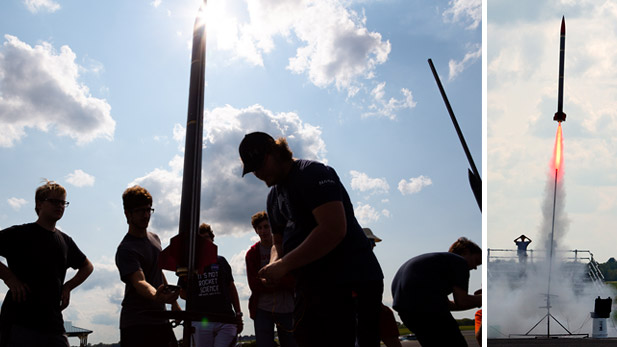Rose Rocketry Set for Liftoff in NASA Student Launch Competition

Rose Rocketry Club members are designing, building and launching an amateur rocket to carry a scientific payload between 4,000 and 6,000 feet into the sky as one of the teams in NASA’s 2023 Student Launch Challenge.
Increased student interest and lessons learned from last year have members of the Rose Rocketry Club enthusiastic about launching their aspirations for participation in NASA’s 2023 Student Launch Challenge.
The team is well on its way toward achieving its goals of designing, building, and flying a high-powered amateur rocket that carries a scientific payload to an altitude between 4,000 and 6,000 feet. The nine-month-long challenge will culminate with an on-site launch near NASA’s Marshall Space Flight Center in Huntsville, Alabama, in April of 2023.
This marks the second straight year that the Rose Rocketry Club has been selected among the 69 student teams representing 25 states and Puerto Rico competing in the challenge.
Rose Rocketry student leaders admit they were overwhelmed by the complexities involving technical aspects in last year’s inaugural effort, with the team failing to meet competition launch requirements because of parachute failure.
“Already cohesion among team members is improved from last year and with a preliminary design nearly ready to be built and tested, we are looking forward to a successful year,” said club president Sam Betts, a third-year mechanical engineering student. “We needed the people, subsystems, and funding to be successful in a competition of this magnitude. We are well on our way to meeting those objectives.”
Student recruitment has brought a team roster with 40 students from a variety of engineering and science academic disciplines. Leadership positions cover each system within the project and Rose Tech Radio Club members are consulting on important in-flight communications. Team leadership also made an important design decision to cap the rocket’s length at six feet.
“We made other hard design decisions early in the production process and are now concentrating on the prototyping and design stages of the competition. We have clear manageable deadlines in between NASA Student Launch Challenge deadlines,” said Betts. “This is a total team effort this year.”
The club president added, “I can't explain how excited I am for this year's competition. I've already seen the interest our members have for the aeronautical field and for the competition, and I have enjoyed getting to know the new people and their interests. We worked hard on the (original competition entry) proposal, and it came together much smoother than last year. I desperately want to make it to the launch part of the competition this year.”
Each year, NASA updates the competition’s payload challenge to mirror technologies needed for existing missions. This year, students must design a payload capable of autonomously receiving commands via radio frequency and completing a series of tasks with an on-board camera. Teams must declare a targeted altitude for their rocket on final launch day, with the team closest to their prediction winning the Altitude Award. Additional awards are presented to deserving teams for vehicle design, experiment design, and social media presence. Teams must conduct outreach programs to educate local communities.
“This competition has the potential to transform students into well-qualified professionals for the modern-day workplace,” said Fred Kepner, activity lead for Student Launch at Marshall, in a NASA news release. “Many former students now work with NASA or our industry partners across the nation, some supporting the next chapter of space exploration, the Artemis program.”
Joining Betts as team leaders are vice president Chirag Sirigere, a senior computer engineering student; treasurer Garrett Hart, a junior electrical engineering major; secretary and mechanical payload subteam leader Everest Zang, a sophomore mechanical engineering student; safety officer and vehicle subteam leader Ben Graham, a junior computer science major; public affairs officer Gabriel Woller, a sophomore mechanical engineering student; and electronics/radio frequency payload subteam leader Jake Armstrong, a sophomore computer engineering major.
---------
Support the Rose Rocketry Team by donating to: https://fundraise.givesmart.com/vf/RHITCompTeams/team/Rocketry
(Funds will support members to attend conferences, travel to the final competition, develop plans for a rocket to reach 10,000 feet in flight, and help members achieve level-2 high-powered rocket certification).